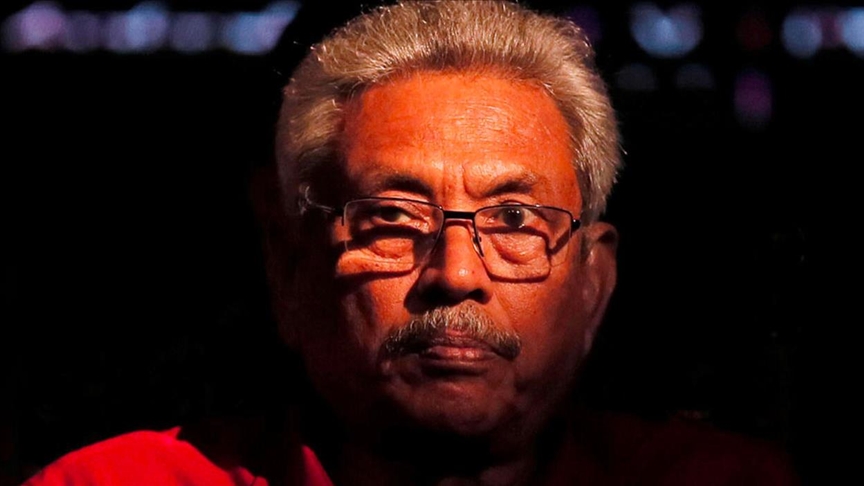Image: Colvin’s prediction became a reality: “someday we may not only have to suffer a bad president but also a mad president”.
“…The point I made about the Aragalaya being fundamentally, an anti-Sinhalese and anti-Buddhist enterprise from the beginning to the end”
(Gotabaya Rajapaksa, THE CONSPIRACY, p 172)
By Dayan Jayatilleka.
Dr. Colvin R. de Silva’s position on the executive presidency was slightly more nuanced than the flat denunciation by Dr. N.M. Perera. While criticising the 1978 Constitution, he took pains in a contribution to the Lanka Guardian magazine to emphasise that the Jayewardene presidential system, though deriving from the Gaullist model of France, has significant accretions and distortions which brought it more into line with those of Francophone Africa. Colvin pointed explicitly to the tyrant Jean-Bedel Bokassa of the Central African Republic. He quipped that the main danger of the over-concentration of power in the 1978 Jayewardene Constitution is that “someday we may not only have to suffer a bad president but also a mad president”.
If the Gotabaya presidency provided the proof of that proposition, GR’s recent memoir, The Conspiracy, is reconfirmation of the absolute validity of comrade Colvin’s dire prediction.
Political ignorance
In his Introduction, Gotabaya says that when a leader is ousted by a mass unrest, he is either a dictator or has been an elected leader who has entrenched himself and manipulated the system for a long time, while he [Gota] himself had been elected only two plus years before his ouster. His underlying argument is that it is unprecedented, therefore unjustified, illegitimate and obviously a conspiracy. Evidently, Gota’s political illiteracy encompasses ignorance about the political history of the Rajapaksa family itself.
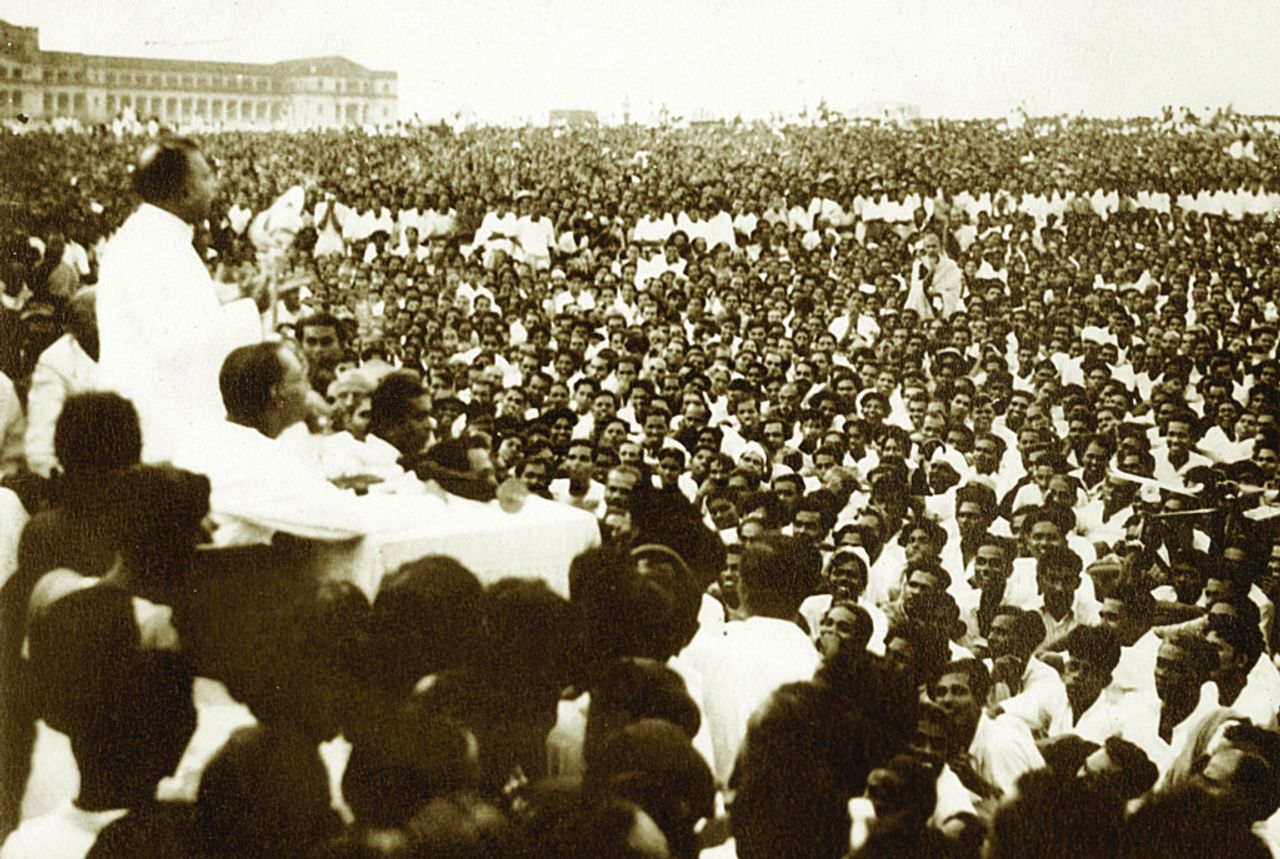
Gota seems unaware that ‘1956’ came downstream from the Great Hartal (‘Maha Harthaalaya’) of August 1953. That was a mass uprising against a government that had won a general election just one year before, in 1952. The Hartal was in protest against a cut in the rice subsidy—far less traumatic than the hell that Gotabaya put the citizenry through.
Called and led by the LSSP and CP, the Hartal was far more forceful than the Aragalaya of 1952. For decades afterwards, the LSSP-CP commemorated the Hartal annually. Left legends heroized the trade union militants who had wielded homemade hand-bombs during that struggle (some were injured). Women stopped trains by baking hoppers on the tracks. Public infrastructure was sabotaged, damaged. Unlike in the Aragalaya, the Federal party joined the Hartal from the North. Police shooting killed 10 people. The Cabinet was evacuated onto an American ship moored in the harbour. In the face of roiling mass anger, Prime Minister Dudley Senanayake, elected the previous year, resigned.
Like Ranil Wickremesinghe, Gotabaya’s acknowledged hero Sir John Kotelawala was never once elected to the country’s leadership. He was appointed (they should’ve picked RG Senanayake), after Dudley Senanayake resigned as PM in the face of the Hartal. The ruling UNP remained in office, just as the SLPP does, until the election.
Though the SLFP didn’t participate as a party in the Hartal, SWRD Bandaranaike chaired the Hartal kick-off rally (indubitably with the Rajapaksas present) at Galle Face Green, the scene of the Aragalaya/GotaGoGama 2022. That irony of history is delectable.
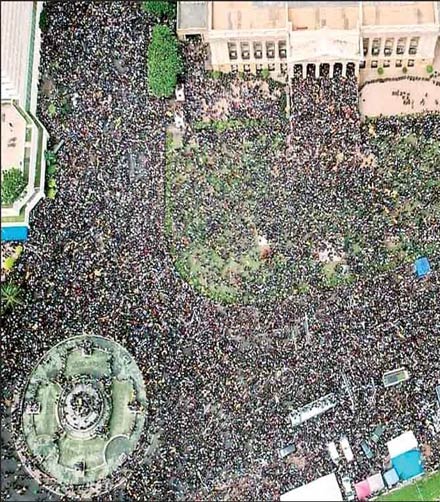
Lanka’s worst leader
Gotabaya’s identification of the main, though not exclusive, internal source of the conspiracy as comprehended by him retrospectively after a long period of reflection, is grimly insidious. His identification or framing is drenched in inflammatory racism and religious hatred. It qualifies as incitement.
Let’s be fair and quote him at some substantive length, instead of paraphrasing him or cherry-picking phrases from his book. Remember, all of this is also in the Sinhala edition of this book. Consider the effect on the Sinhala-Buddhist reader, over years.
 “…Due to a multiplicity of factors, the Tamil and Muslim communities both came together in the Aragalaya to oppose me. This was obvious in all the protests held especially in Colombo and may have been motivated by the fear that if I continued in power, the Sinhala Buddhists would have been strengthened to the detriment of the minorities.
“…Due to a multiplicity of factors, the Tamil and Muslim communities both came together in the Aragalaya to oppose me. This was obvious in all the protests held especially in Colombo and may have been motivated by the fear that if I continued in power, the Sinhala Buddhists would have been strengthened to the detriment of the minorities.
 …As I pointed out in the introduction to this book, my very election to power was the result of a contest between the Sinhala and Buddhist interests on the one hand and all non-Sinhala and non-Buddhist elements on the other hand. Sections of the Roman Catholic Church also joined this lineup from the end of 2021 onwards despite the excellent relationship that I had maintained with the Catholic Church up to that time.
…As I pointed out in the introduction to this book, my very election to power was the result of a contest between the Sinhala and Buddhist interests on the one hand and all non-Sinhala and non-Buddhist elements on the other hand. Sections of the Roman Catholic Church also joined this lineup from the end of 2021 onwards despite the excellent relationship that I had maintained with the Catholic Church up to that time.
 If anyone was under the impression that the objective of the Aragalaya was to eliminate fuel queues, gas queues and shortages of medicines and other essential items and to ease the hardships of the people, that is a delusion. The people participating in the Aragalaya had very different objectives and priorities. From day one, the so-called Aragalaya was an operation inimical to Sinhala and particularly Sinhala-Buddhist interests, and it was well supported by foreign interests that had much the same objectives.” (pp. 89-92)
If anyone was under the impression that the objective of the Aragalaya was to eliminate fuel queues, gas queues and shortages of medicines and other essential items and to ease the hardships of the people, that is a delusion. The people participating in the Aragalaya had very different objectives and priorities. From day one, the so-called Aragalaya was an operation inimical to Sinhala and particularly Sinhala-Buddhist interests, and it was well supported by foreign interests that had much the same objectives.” (pp. 89-92)
 “…The point I made about the Aragalaya being fundamentally, an anti-Sinhalese and anti-Buddhist enterprise from the beginning to the end”. (Postscript, p 172)
“…The point I made about the Aragalaya being fundamentally, an anti-Sinhalese and anti-Buddhist enterprise from the beginning to the end”. (Postscript, p 172)
 “…One of the reasons why I was elected President was because of the feeling that the Sinhalese had lost their rightful place in their own country…The Sinhalese and especially the Sinhala Buddhists are now once again on the back foot.” (Postscript, pp 169-177)
“…One of the reasons why I was elected President was because of the feeling that the Sinhalese had lost their rightful place in their own country…The Sinhalese and especially the Sinhala Buddhists are now once again on the back foot.” (Postscript, pp 169-177)
 “…However, my departure from office has left unaddressed the three main issues that got me elected to power—the fact that the Sinhalese and particularly the Sinhala Buddhists are being taken for granted, ignored, sidelined, downtrodden and humiliated by various foreign and local powers, the deterioration of the economy and the massive indebtedness of the country, and the total failure on the law and order, national security and intelligence fronts. These unaddressed issues will have to be dealt with by another leader in the future. My fervent hope is that Sri Lanka finds this leader sooner rather than later.” (Postscript, p 179)
“…However, my departure from office has left unaddressed the three main issues that got me elected to power—the fact that the Sinhalese and particularly the Sinhala Buddhists are being taken for granted, ignored, sidelined, downtrodden and humiliated by various foreign and local powers, the deterioration of the economy and the massive indebtedness of the country, and the total failure on the law and order, national security and intelligence fronts. These unaddressed issues will have to be dealt with by another leader in the future. My fervent hope is that Sri Lanka finds this leader sooner rather than later.” (Postscript, p 179)
While I reject the interpretation that traces Sri Lanka’s economic collapse back to 1948, my first book (Vikas, New Delhi 1995) sources Sri Lanka’s “Protracted Crisis” in the postcolonial failure to build a unified Sri Lankan identity and nationhood.
As repeatedly identified by Singapore’s Lee Kuan Yew, Ceylon’s tragedy was the inability to integrate the majority and minorities on the basis of non-discrimination and meritocracy. According to Lee, the principal problem was Sinhala majoritarian chauvinism. If that was the root cause of Sri Lanka’s protracted crisis, then the most explicit advocate of that ideology among all of Ceylon’s/Sri Lanka’s leaders since Independence, has been Gotabaya Rajapaksa. This is evidenced in the quotes above, which show that even after the Aragalaya and his ouster, his chauvinism has not been dissipated or tempered by experience. In The Conspiracy, he spews the kind of racism that Cyril Mathew did, which ignited Black July 1983.
Missing majority
Gotabaya’s anti-minority reconstruction of his ouster is not merely morally reprehensible, it flies in the face of logic and reason. Had the Aragalaya been minoritarian, why was the majority silent, especially when the ruling party was the SLPP? What happened to the 6.9 million Sinhala Buddhists who voted for him? Why was there no majoritarian backlash to defend the great champion of the Sinhala Buddhists?
When Mahinda Rajapaksa lost the 2015 election, there was stupefied grief among the majority. For months, hundreds of thousands of people journeyed South and kept lining up outside Medamulana to see MR and persuade him to return to give them leadership. Nothing of the sort happened in Gotabaya’s case, during or after the Aragalaya, to date.
What ethnicity or religion does Gotabaya think the millions of farmers whose crops were ruined by his lunatic fertilizer policy belonged to? They were mostly Sinhala Buddhists.
Why does he think the soldiers in the barracks were in sympathy with the Aragalaya demonstrators and consorting with them on the streets? Because their parents, extended families and villages were suffering due to Gotabaya’s policy of ‘agricide’. They were mostly Sinhala Buddhists.
What does he think is the ethno-religious background of the overwhelming majority of university students who spearheaded the Aragalaya? For generations they have been mainly from rural Sinhala Buddhist families.
Far from the Aragalaya being minoritarian in composition, the one part of the island that did not participate in that great struggle, unlike during Hartal 1953, was the North and East (with the solitary, sporadic exception of the Eastern university). If it was the Tamil and Muslims who were the main force of the Aragalaya and were chiefly motivated to oust Gotabaya, why then were those areas of the island in which they preponderate almost totally silent and unmoved by the Aragalaya?
Gotabaya was not ousted by any darn conspiracy. He was ousted because his irrationality in policy was matched only by his autocratic arrogance in discourse and style. His ignorance and arrogance far outweighed his competence, and his triple attributes of irrationality-arrogance-incompetence traduced the Lankan ethos and exceeded the threshold of tolerance of its sovereign people.
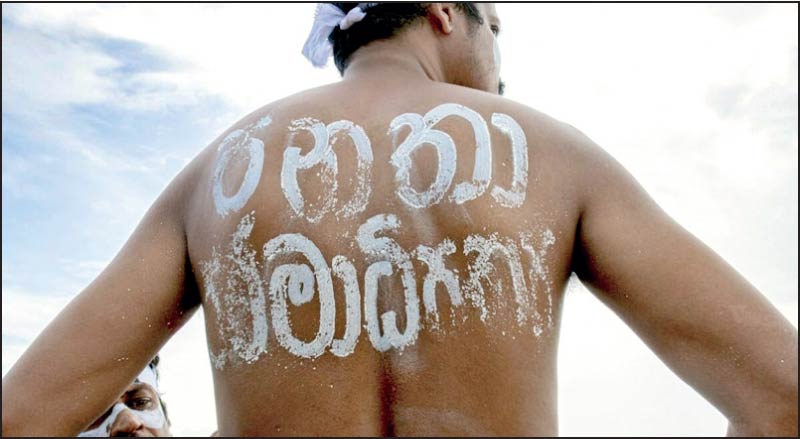
Gota was chased from the Presidency by the unarmed citizenry, i.e., by ‘people’s power’, because he had neither enough intelligence nor empathy; neither sufficient brains nor heart. If Gota had enough brains he would have known that Sri Lanka wasn’t a military barracks but a democratic republic in which the citizens were sovereign. He wouldn’t have ordered the overnight, island-wide ban of chemical fertilizer-weedicide-pesticide, without a pilot project in a single district, despite not having a single precedent of success anywhere on the planet, and against the written plea of all agricultural experts and agronomists (April 2021). He would have reversed course when it was obvious that the policy was hitting export crops and reducing our foreign exchange earnings. The real “intelligence failure” was of Gotabaya Rajapaksa’s own intelligence.
If Gota had a heart, he would have been moved by the wailings, entreaties and later, the curses, of the poor peasants, as seen from every part of the country, including the Rajapaksas’ traditional Southern support base, on TV newscasts each night.
Nor did he give a damn about the exploding gas cylinders which were killing people in the kitchens of their homes. The cylinders were exploding because the authorities Gota had appointed had approved changes in ratios of the gases in the cylinders. The Gotabaya administration’s ‘investigative’ teams attempted to blame the victims, saying the gas cylinders had been imperfectly connected to the cookers or the connecting mechanism had not been renewed in time and therefore been corroded.
Most of those crying and beseeching peasant women, and the families in mourning due to the ‘barrel bombs’ exploding in homes, were Sinhala Buddhists.
So, Gotabaya, the champion of Sinhala Buddhism, wrecked the traditional historical-civilizational base of the Sinhala Buddhists, and the food self-sufficiency of the nation—the peasantry and the paddy fields.
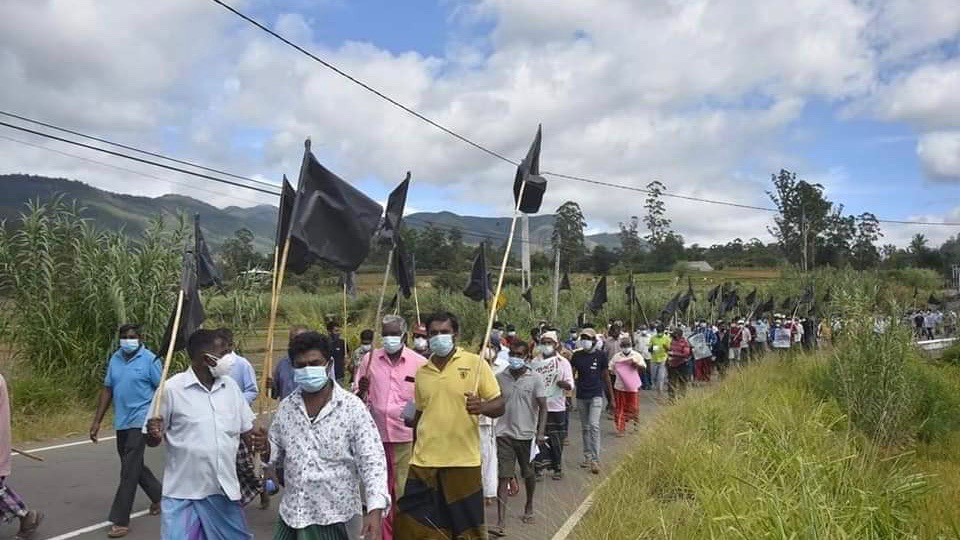
Gotabaya Rajapaksa’s mind is mirrored in his chapter on Organic Fertilizer. His method is that somebody brings him some idea of potentiality irrespective of context, or he has a bee in his own bonnet, and he arbitrarily imposes a ban without any further consultation, prior study or pilot project. He does not appoint expert panels in the subject to prepare a feasibility report. He grapples with the predictable issue of shortfall by some slapdash solution, e.g., a shipload of organic fertilizer, paid for in dwindling foreign currency, from China, to serve the agricultural needs of the whole country.
Gotabaya claims the conversion to organic agriculture was contained in his election manifesto Vistas of Prosperity. That’s more obfuscatory lie than fact. ‘Vistas’ said (in Sinhala) the conversion would be “within the forthcoming decade” and “organic fertilizer production speeded-up, to that end”. That hardly justifies Gotabaya’s whacko, monstrous, overnight countrywide ban.
Easter massacre spin
Gotabaya writes that “Sections of the Roman Catholic Church also joined this lineup from the end of 2021 onwards despite the excellent relationship that I had maintained with the Catholic Church up to that time.” ‘Up to that time’, ‘the excellent relationship’ he had maintained with the Roman Catholic Church included jailing an Indian nun belonging to the Order founded by Mother Teresa, and sending the Army into Rathupaswela where they shot into a church, made Catholic nuns kneel outside, pulled out a man who had been sheltering in the church (and phoned his wife reassuringly from there) and caved his head in with gun-butts.
Gotabaya’s book has a long chapter on the Easter massacre and subsequent inquiries. He reiterates the ‘ISIS Only’ line. That’s plain ‘organic fertilizer’, i.e., bulls**t.
On Oct 7th 2024, Hamas attacked Israeli soldiers (killing 350) and civilian ‘kibbutzim’. Hideous as the civilian killings were – though incomparably outweighed by Israel’s genocidal war on Gaza—there was a logic: these were perceived as settler-occupiers on Palestinian lands originally belonging to the refugee families in Gaza. Now, what if instead of attacking Zionist soldiers and settlers, Hamas had massacred – suicide-bombed–the small Christian community in Gaza or the larger one in the West Bank? That would have made no sense because there was never any enmity between the two.
Similarly, the targeting of Catholic and Christian churches and churchgoers on Easter Sunday by Zahran’s group makes no sense whatsoever. There were never any issues between them. The “Christchurch, NZ” explanation makes zero sense. This attack was by a homegrown Islamist group not a group of alienated recent immigrants as in the West, or a multinational, cross-border, nomadic group like ISIS. There was a history of violent Islamophobia perpetrated since 2012 by militant Sinhala Buddhist organizations like the BBS, but no such targets were attacked in retaliation. Sinhala Buddhists were avoided and utterly uninvolved Catholics and Christians slaughtered instead. Where’s the motivation for suicide-bombers?
Gotabaya is accurate about one thing: starting “end of 2021”, the prayer campaign and demonstrations by the Catholic community seeking justice for the victims of the Easter massacre formed the prequel to the Aragalaya which toppled him.
Any possible culpability –sins of commission or omission– of former top securocrats in the Easter massacre which tilted the 2019 nomination and presidential election outcome, will surely be investigated by an independent inquiry appointed by a new post-election Government, and wouldn’t be covered by Presidential immunity.
Gota’s grotesque hypocrisy
Gotabaya rails against the status of the Sinhala Buddhists today: “…the Sinhala Buddhists are being taken for granted, ignored, sidelined, downtrodden and humiliated by various foreign and local powers…”
If so, all this is being perpetrated under/by the leadership of Ranil Wickremesinghe who was Gota’s pick over Sarath Fonseka (p150) as Prime Minister, which positioned him for the presidency to which he was elected (rejecting Dullas Alahapperuma) by the SLPP led by the Rajapaksas. Whatever is allegedly befalling the Sinhala Buddhists is also perpetrated by a heavily SLPP-dominated Cabinet.
Gotabaya’s book exemplifies why, 15 years after we won the war–capped by victory in the UNHRC Geneva diplomatic battle–in May 2009, we haven’t won the peace. Hawkishly obstructionist as postwar Secretary/Defence, Gotabaya as President implemented a Netanyahu-type policy especially in the East. The Aragalaya gave peace a chance.
Courtesy of The Daily FT.
